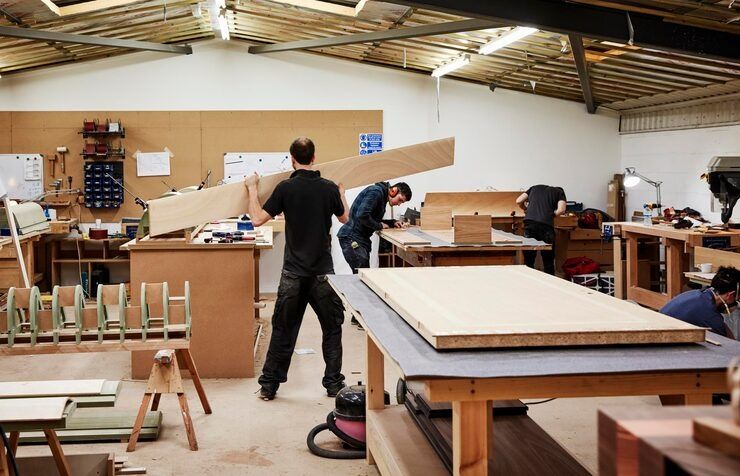Furniture manufacturing refers to the process of designing, producing, and assembling furniture items for residential, commercial, and industrial use. This industry encompasses a wide range of materials, including wood, metal, plastics, and composite materials, and utilizes both traditional craftsmanship and modern automated technologies.
Importance
Furniture manufacturing is significant for economic, social, and practical reasons:

-
Economic contribution: Generates revenue, supports small and large businesses, and creates employment across production, logistics, and retail sectors.
-
Design innovation: Drives creativity and trends in home and office interiors, impacting lifestyle and comfort.
-
Material efficiency: Advances in production optimize the use of wood, metal, and sustainable materials.
-
Industrial application: Supplies essential furniture for offices, schools, hospitals, and hospitality sectors.
-
Cultural and aesthetic value: Reflects regional craftsmanship, heritage, and design preferences.
By combining functionality, aesthetics, and sustainability, furniture manufacturing plays a vital role in daily life and industry.
Recent Updates
The furniture manufacturing sector has seen several key developments in 2023–2024:
-
Sustainable materials: Increased use of recycled wood, bamboo, and eco-friendly composites.
-
Smart furniture: Integration of technology like adjustable desks, charging stations, and modular designs.
-
Automation: CNC machines, robotic assembly, and AI-driven cutting tools improve precision and reduce production time.
-
Digital design tools: CAD and 3D modeling facilitate efficient prototyping and virtual showrooms.
-
Global supply chain evolution: Manufacturers are sourcing materials locally and internationally to reduce lead times and logistics challenges.
-
Customizable furniture trends: Consumers increasingly demand personalized solutions with flexible designs and finishes.
These trends emphasize innovation, sustainability, and responsiveness to changing consumer and industrial needs.
Laws or Policies
Furniture manufacturing is regulated to ensure safety, quality, and environmental compliance:
-
Product safety standards: Regulations govern fire resistance, load-bearing capacity, and durability.
-
Environmental regulations: Guidelines address emissions, waste management, and sustainable sourcing of timber and other materials.
-
Labor laws: Protect worker safety, working hours, and conditions in manufacturing facilities.
-
Trade policies: Import/export regulations affect material procurement, tariffs, and international shipments.
-
Certification programs: ISO standards, FSC certification, and other quality certifications ensure adherence to best practices.
Compliance ensures that manufacturers produce safe, durable, and environmentally responsible furniture.
Tools and Resources
Several tools and resources help manufacturers, designers, and businesses optimize production and workflow:
-
CAD and 3D modeling software: Tools like AutoCAD, SolidWorks, and SketchUp support design and prototyping.
-
ERP systems: Manage inventory, procurement, production schedules, and logistics.
-
Material calculators: Estimate wood, metal, or composite usage to minimize waste.
-
Automation equipment: CNC routers, laser cutters, and robotic arms enhance precision and speed.
-
Industry associations: Organizations provide training, standards, market reports, and networking opportunities.
-
Virtual showrooms and AR apps: Enable customers and designers to visualize furniture in real-world settings.
Example Table: Common Furniture Manufacturing Techniques
| Technique | Description | Applications |
|---|---|---|
| Wood Joinery | Traditional methods like dovetail, mortise, tenon | Chairs, cabinets, tables |
| CNC Machining | Computer-controlled cutting and shaping | Precision parts, modular furniture |
| Upholstery | Padding and fabric/leather covering | Sofas, chairs, headboards |
| Metal Fabrication | Welding, bending, and finishing of metal | Office furniture, frames, industrial units |
| Lamination and Veneering | Layering materials for durability and aesthetics | Cabinets, countertops, decorative panels |
This table highlights the versatility of furniture manufacturing techniques and their specific applications.
FAQs
What materials are commonly used in furniture manufacturing?
Wood, metal, plastic, glass, and composite materials are widely used, with growing emphasis on sustainable sources.
How has technology changed furniture manufacturing?
Automation, CNC machining, CAD design, and digital prototyping have increased precision, reduced waste, and accelerated production.
Is sustainable furniture manufacturing possible?
Yes, using responsibly sourced materials, eco-friendly finishes, and energy-efficient processes promotes sustainability.
What industries rely on furniture manufacturing?
Residential, hospitality, healthcare, office, education, and retail sectors all depend on quality furniture production.
What certifications ensure quality in furniture manufacturing?
ISO standards, FSC-certified wood, ANSI/BIFMA for office furniture, and fire safety certifications ensure quality, safety, and sustainability.
Conclusion
Furniture manufacturing combines art, engineering, and technology to produce functional and aesthetically appealing products. The industry supports economies, drives innovation, and provides essential products for homes, offices, and public spaces.
Recent trends in sustainability, automation, and digital design demonstrate the sector’s adaptability and forward-looking approach. By adhering to safety, environmental, and labor regulations, manufacturers can create durable, high-quality, and eco-friendly furniture.
With advanced tools, materials, and techniques, furniture manufacturing continues to meet evolving consumer demands while promoting efficient, innovative, and responsible production practices.